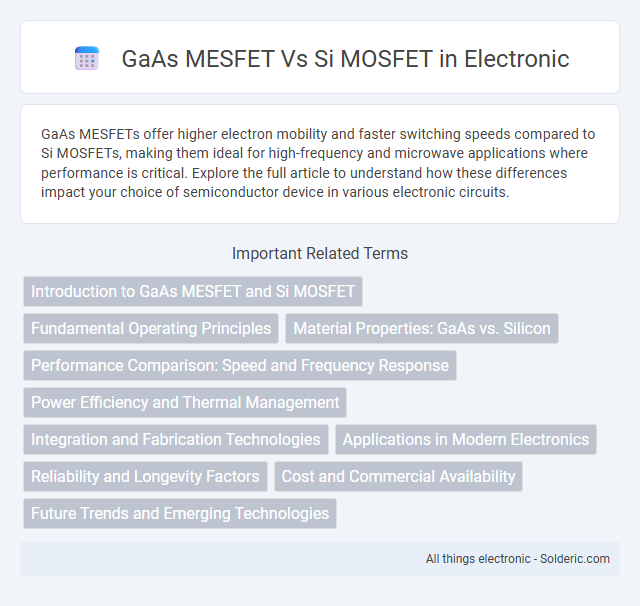GaAs MESFETs offer higher electron mobility and faster switching speeds compared to Si MOSFETs, making them ideal for high-frequency and microwave applications where performance is critical. Explore the full article to understand how these differences impact your choice of semiconductor device in various electronic circuits.
Comparison Table
| Parameter | GaAs MESFET | Si MOSFET |
|---|---|---|
| Material | Gallium Arsenide (GaAs) | Silicon (Si) |
| Electron Mobility | High (~8500 cm2/V*s) | Moderate (~1400 cm2/V*s) |
| Operating Frequency | Up to 100 GHz (High-frequency applications) | Up to few GHz (Low to moderate frequencies) |
| Noise Performance | Low noise, suitable for RF amplifiers | Higher noise compared to GaAs MESFET |
| Power Handling | Higher power density | Lower power density |
| Thermal Conductivity | Lower (~46 W/m*K) | Higher (~150 W/m*K) |
| Fabrication Complexity | More complex and expensive | Less complex, cost-effective |
| Typical Applications | Microwave, RF amplifiers, high-speed digital circuits | General purpose digital circuits, power management |
Introduction to GaAs MESFET and Si MOSFET
GaAs MESFETs (Gallium Arsenide Metal-Semiconductor Field-Effect Transistors) utilize a Schottky gate contact on GaAs substrates, offering high electron mobility and superior frequency performance for microwave and RF applications. Si MOSFETs (Silicon Metal-Oxide-Semiconductor Field-Effect Transistors) dominate digital and analog circuits due to silicon's cost-effectiveness, well-developed fabrication technology, and excellent scalability. While GaAs MESFETs excel in high-speed, high-frequency scenarios, Si MOSFETs provide robust switching characteristics and integration density for mainstream electronics.
Fundamental Operating Principles
GaAs MESFETs operate using a depletion-mode mechanism with a Schottky barrier gate controlling the channel conductivity in gallium arsenide material, enabling high electron mobility and fast switching speeds. Si MOSFETs function through an inversion layer formation under an insulated gate electrode on silicon substrates, relying on voltage-controlled conduction modulation within a metal-oxide-semiconductor structure. The inherent material properties of GaAs provide superior electron velocity and lower noise performance compared to silicon, influencing their respective device operation efficiencies.
Material Properties: GaAs vs. Silicon
Gallium Arsenide (GaAs) offers higher electron mobility compared to Silicon, resulting in faster switching speeds and improved high-frequency performance in MESFET devices. Silicon's superior thermal conductivity and well-established fabrication processes provide cost-effective manufacturing and better heat dissipation for MOSFETs. Your choice between GaAs MESFET and Si MOSFET depends on the balance between speed requirements and thermal management needs in your application.
Performance Comparison: Speed and Frequency Response
GaAs MESFETs exhibit significantly higher electron mobility than Si MOSFETs, resulting in superior speed and enhanced high-frequency performance, making them ideal for RF and microwave applications reaching tens of gigahertz. Si MOSFETs, while slower due to lower carrier mobility, offer excellent integration with CMOS technology and cost-effectiveness for digital circuits operating in the megahertz to low gigahertz range. Your choice depends on whether ultra-high-speed and frequency response or integration and cost efficiency is the primary requirement in your application.
Power Efficiency and Thermal Management
GaAs MESFETs exhibit superior power efficiency compared to Si MOSFETs due to higher electron mobility, enabling faster switching speeds and reduced on-resistance. Their wide bandgap material also contributes to better thermal management by allowing operation at higher temperatures with less heat generation. In contrast, Si MOSFETs often require more complex cooling solutions due to higher thermal losses and lower saturation velocity.
Integration and Fabrication Technologies
GaAs MESFETs offer superior electron mobility and high-frequency performance but face challenges in large-scale integration and cost-effective fabrication compared to Si MOSFETs. Silicon-based MOSFETs benefit from mature CMOS technology, enabling high-density, low-cost integration essential for mainstream semiconductor devices. Your choice between GaAs MESFET and Si MOSFET depends on the application's priority for high-speed operation versus integration complexity and manufacturing scalability.
Applications in Modern Electronics
GaAs MESFETs excel in high-frequency and microwave applications, making them ideal for radar systems, satellite communications, and high-speed RF circuits due to their superior electron mobility and low noise performance. Si MOSFETs dominate power electronics, digital integrated circuits, and general-purpose amplifiers because of their cost-effectiveness, thermal stability, and compatibility with large-scale silicon processing technologies. The choice between GaAs MESFET and Si MOSFET hinges on specific application requirements like frequency range, power efficiency, and integration scale in modern electronic devices.
Reliability and Longevity Factors
GaAs MESFETs demonstrate superior radiation hardness and high-frequency performance, contributing to enhanced reliability in harsh environments compared to Si MOSFETs. Si MOSFETs, while offering better thermal stability and established manufacturing processes, can experience degradation due to hot-carrier injection and oxide layer limitations affecting longevity. The choice between GaAs MESFET and Si MOSFET depends on application-specific requirements, balancing GaAs's robustness under stress with Si's mature reliability in standard conditions.
Cost and Commercial Availability
GaAs MESFETs typically incur higher manufacturing costs than Si MOSFETs due to expensive substrate materials and complex fabrication processes. Si MOSFETs benefit from mature silicon processing technology, making them widely available and cost-effective for mass production. Your choice between them hinges on balancing budget constraints with performance requirements related to cost and commercial accessibility.
Future Trends and Emerging Technologies
GaAs MESFETs are advancing in high-frequency and high-power applications due to their superior electron mobility and thermal performance compared to Si MOSFETs, making them critical for 5G, millimeter-wave radar, and satellite communications. Silicon MOSFETs continue to dominate mainstream digital circuits with ongoing innovations in scaling, power efficiency, and integration with CMOS technology enabling AI accelerators and IoT devices. Your choice between GaAs MESFET and Si MOSFET will increasingly depend on application-specific requirements such as frequency range, power density, and system cost in future emerging technologies.
GaAs MESFET vs Si MOSFET Infographic

 solderic.com
solderic.com